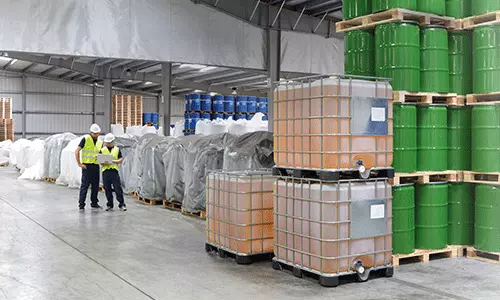Storage of hazardous substances
Hazardous substances in the company: 5 tips for safe storage
Chlorine, mineral oils: in many companies, flammable or toxic hazardous substances are part of everyday operations. These cannot be stored, especially in large quantities, without safety precautions being taken. What is important when it comes to storage? What are the legal requirements? And when do you need a drip tray? You can find this out in our 5 tips for storing hazardous substances.

1 Store in the right place
With many hazardous substances, it is not immediately apparent what their storage location should be like. But what’s always important: store hazardous materials somewhere where they cannot fall, for example at the very bottom of a rack or in containers that can be safely stacked. Where large amounts of hazardous substances are concerned, you may need a hazardous substances depository or a safety room container. Flammable hazardous substances may not be stored in stairwells, passageways, corridors and attics due to legal regulations.
2 Label hazardous substances
Adequately label toxic, flammable or other hazardous substances. Hazard pictograms ensure that even uninvolved persons can recognise the hazardous substance. In addition, hazardous substances must never be stored in the vicinity of foodstuffs or pharmaceuticals in order to avoid any confusion arising.
3 Use original containers and drip trays
The basic rule is to leave hazardous materials in the original container, especially if they are unbreakable and leak-proof. Do not refill products with hazardous substances and ensure that the container is, and remains, intact. For larger quantities of liquid hazardous substances, drip trays protect against contamination of the environment. According to the law, these must be able to hold at least ten percent of the storage volume or the largest container size stored. In water protection areas, the collection facility must be capable of receiving the entire quantity stored.
4 Restrict access to hazardous substances
Only employees familiar with the handling of hazardous substances should have access to them. Store them, for example, in a safety cabinet that can be locked and that can only be accessed by competent persons.
5 Inform yourself about further guidelines
All the important information on the subject of the "storage of hazardous substances in transportable and stationary containers" can be found, directly from the regulations, in Gefahrstoffverordnung GefStoffV, AwSV, TRGS 510 and TRGS 509. This is how you play it safe!



